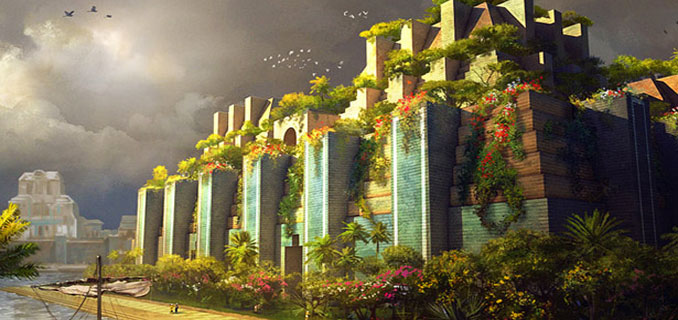
2013 04 17By John Henzell | TheNational
Ever since the peak of the Hellenic empire, visiting the seven wonders of the ancient world has been the way to pay homage to the early achievements of human civilisation.
But there was one catch for those who wanted to see them all. The farthest one from Athens, the famed Hanging Gardens of Babylon, in what is now central Iraq, existed in reports but its exact location had never been definitively proven.
Of the other six, the pyramids of Giza remain relatively intact and there are ruins or at least traces of the temple of Artemis at Ephesus, the statue of Zeus at Olympia, the mausoleum at Halicarnassus, the Colossus of Rhodes and the lighthouse of Alexandria.
Finding traces of the Hanging Gardens became a kind of ultimate goal for archeologists and antiquarians but every investigation of the site of Babylon, near the modern Iraqi town of Al Hillah, came up short. Some postulated that the gardens might have been legendary rather than real.
This is where Dr Stephanie Dalley comes in.
Her academic speciality is early Mesopotamian civilisations: she is an expert in ancient Babylonian language and has taken part in archeological excavations in the fertile crescent where human civilisation began.
Now retired from the University of Oxford, she is visiting Abu Dhabi and giving a lecture tonight about her theory that the Hanging Gardens existed but that an ancient misunderstanding led the Greeks who compiled the original seven wonders to site them in Babylon, when the gardens were really in the neighbouring Assyrian empire.
Next month the Oxford University Press will publish The Mystery of the Hanging Garden of Babylon, Dr Dalley’s account of her exhaustive 20-year pursuit of the truth about the gardens.
According to antiquarian reports, the Hanging Gardens were built in the citadel of the Babylonian ruler Nebuchadnezzar II, who ordered the recreation of the mountainous homeland of his homesick wife, Amytis of Media.
By all accounts, it was a true wonder, with a raised garden at the very top of the citadel that was big enough for full-size trees to grow.
Built on a series of arches as a quadrangle with sides four plethra (123 metres) long, surrounded by walls six metres thick and with passages wide enough that "four-horse chariots can easily pass each other".
Nebuchadnezzar II ruled the city-state of Babylon on the Euphrates River between 604BC and 562BC and the gardens were supposed to have been destroyed by earthquakes sometime in the 2nd century BC.
But although there were numerous reports of the Hanging Gardens by later Greek and then Roman writers, they all quote from an earlier text by Berossus, a Babylonian priest. Berossus’s original work has never been found. However, Dr Dalley came to question the accuracy of those reports, beginning a kind of CSI Mesopotamia to unravel the truth from the fiction.
One factor that triggered her suspicions is that the gardens are not mentioned in other earlier texts in which Nebuchadnezzar II had recorded in detail his other building projects in the city state.
Other writers who visited Babylon during the era when the Hanging Gardens were believed to exist, such as Herodotus, Xenophon and Pliny, also made no mention of them.
An extensive and painstaking 19-year excavation of Babylon by German archaeologists at the start of the 20th century had also failed to produce anything to corroborate the Hanging Gardens’ existence.
At the time, the local building style was mud brick, which would not have survived centuries of use supporting an irrigated garden. And the garden also predated the invention of the Archimedes screw irrigation method.
There were two main civilisations in ancient Mesopotamia in that era: the Babylonians in the south and the Assyrians in the north, centred on Nineveh, near what is now Mosul.
The two were often confused in biblical and classical writings, such as the Old Testament book of Judith which calls Nebuchadnezzar the king of the Assyrians and said he lived in Nineveh, when in reality he lived in Babylon. Arab writers describe an earlier ruler, Sennacherib, as being based in Babylon when he actually ruled from Nineveh.
All this raised the question: are the reports of the Hanging Gardens of Babylon actually mistakenly describing a feature in Nineveh instead?
[...]
Read the full article at: thenational.ae
No comments:
Post a Comment